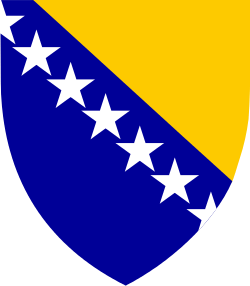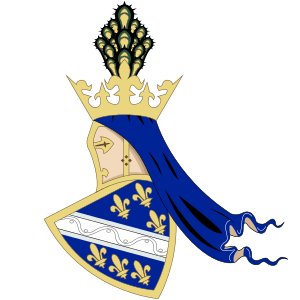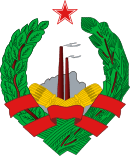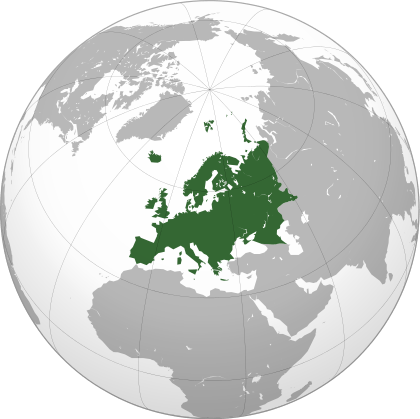Coat of arms of Bosnia and Herzegovina
| Coat of arms of Bosnia and Herzegovina | |
|---|---|
 | |
| Details | |
| Armiger | Bosnia and Herzegovina |
| Adopted | 18 May 1998 |
| Escutcheon | Per bend enhanced Or and azure, a bend of mullets palewise argent |
The coat of arms of Bosnia and Herzegovina was adopted in 1998, replacing the previous design that had been in use since 1992 when Bosnia and Herzegovina gained independence. It follows the design of the national flag. The three pointed shield is used to symbolize the three major ethnic groups of Bosnia, as well as allude to the shape of the country.
Historic arms
One of the earliest, if not the earliest, coats of arms attributed to Bosnia come from the Fojnica armorial, which was completed in 1340. The Fojnički arms are shown upon a gold shield, two black ragged staffs are crossed in saltire with two Moor's heads surmounting the upper portion of each staff. Overall is a red inescutcheon that was charged with an eight-pointed star and crescent. In the subsequent centuries, European sources would attribute arms to Bosnia that were heavily influenced by this depiction.

The coat of arms of the Kings of Bosnia, who ruled from 1377 until 1463 over the area that is present day Bosnia-Herzegovina and Dalmatia, consisted of a blue shield with six gold fleur de lys displayed around a white bend; the fleur de lys perhaps symbolic of Lilium bosniacum, which is a native lily to the area. The crest is a plume of peacock feathers that sit within a coronet of fleur de lys. The House of Kotromanić reigned until 1463 when the Ottomans conquered the region, ceasing then the use of the royal coat of arms in Bosnia. The heraldic display of the kings would later be the basis for the arms adopted by the republic in 1992.
After Herzegovina and Bosnia were occupied by the Austrian-Hungarian Empire in 1878, both condominia received arms from the Empire. The heraldic achievement of Stjepan Vukčić Kosača served as inspiration, who was a fifteenth-century nobleman that ruled over the region as Grand Duke of Bosnia and Herzeg of St. Sava. His armorial bearings displayed both a red armoured arm brandishing a sword and a red lion rampant upon a white shield, with two red bars running across the chief. Herzegovina would be given a red shield with a bare arm holding a broken lance for its coat of arms in this same fashion. The coat of arms of Bosnia would be gold with a red armoured arm issuing out of clouds, brandishing a sword. Though both condominia fell under the crown of Hungary, only Bosnia would be included in the greater arms of the Hungarian Kings.
In the nineteenth century, the nationalist movement that had risen against both the former Ottoman rule and contemporary Austro-Hungarian occupation temporarily revived the arms from the Fojnica armorial.
_(17th_century).svg.png)
17th century. A similar coat of arms is shown in the Korenić-Neorić Armorial (1595).

1668

1878–1918
Communist Era

The emblem, along with the flag, of the socialist Republic of Bosnia and Herzegovina was adopted on December 31, 1946. The description of the emblem was similar to the other Yugoslav republics. The device had two crossing stems of wheat in front of scheme of a neighborhood with two factory chimneys out of which there is smoke. Around the decorative branches and wheat, there is a red track that spirals around. At the top of the emblem is a red star with a golden frame. The red star symbolizes the socialism and communism of Yugoslavia at the time.
The device represents the industry Bosnia and Herzegovina had at the time. The factory chimneys show the industry of several important Bosnian, then Yugoslav, towns and their vital influence towards the economy. All of the Yugoslav republics had similar emblems, but Bosnia and Herzegovina was the only that did not portray nationalistic symbols, representing its multiethnic composition.
The national emblem of the Socialist Republic of Bosnia and Herzegovina was exactly the same as was the previous device of the People's Republic of Bosnia and Herzegovina and defined in its Constitution. This was the first emblem ever in the history of both the regions of Herzegovina and Bosnia that was specific to the entire modern country of Bosnia and Herzegovina.[1]
Modern arms
.svg.png)
The coat of arms of the Republic of Bosnia and Herzegovina was similar to that of the Kotromanić dynasty. It had a blue background divided by a white line. The diagonal white line is actually supposed to symbolize the sword of Tvrtko and his might as a ruler. The coat of arms was designed in a hurry, right at the beginning of the Bosnian War, which lasted for three years. At the end of the war, there came uproar from the Bosnian Serbs arguing that the coat of arms solely represented Bosniaks. The international community within Bosnia and Herzegovina was the instrument to solve the controversy. In early 1998, a commission for the flag change was created and the same year the current coat of arms was adopted in order to help alleviate the tensions among ethnicities.
The current coat of arms of Bosnia and Herzegovina presents the typical straight top, oval sides, and spiked bottom. The coat of arms has two background colors, dark blue and gold. Both colors are seen in the coat of arms between 1992 and 1998. Even though the current coat of arms does not directly relate with Bosnian-Herzegovinian history, the colors that were used were the ones from the former coat of arms. The top right corner forms a yellow triangle symbolizing the shape of Bosnia and Herzegovina, with the blue covering the remaining portions of the flag portraying the sky, rivers and lakes.
See also
- Coat of arms of Herzeg-Bosnia
- Coat of arms of the Federation of Bosnia and Herzegovina, for the sub-national entity's coat of arms
- Seal of Republika Srpska, for the sub-national entity's emblem
References
- ↑ Đorđević, Jovan. Ustavno pravo FNRJ, Izd. Arhiva za pravne i društvene nauke, Beograd, 1953., str. 427.
External links
- "Bosnia and Herzegovina-Coat of Arms". Flags of the World.
- "Bosnia and Herzegovina: Coat of Arms". BosnianFacts.info.
